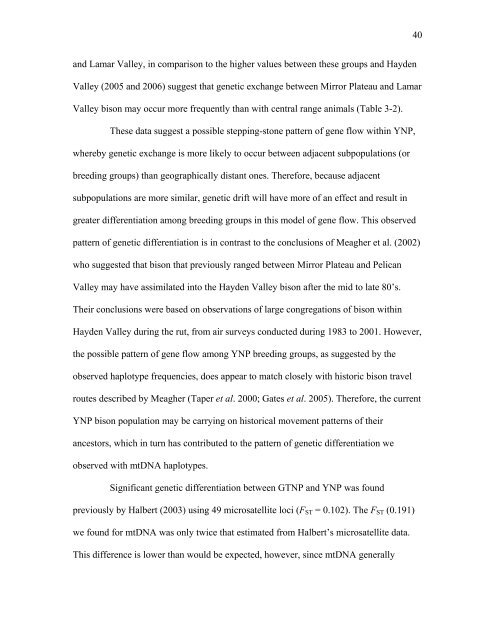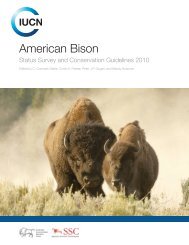Declaration Dr. Thomas H. Pringle - Buffalo Field Campaign
Declaration Dr. Thomas H. Pringle - Buffalo Field Campaign
Declaration Dr. Thomas H. Pringle - Buffalo Field Campaign
Create successful ePaper yourself
Turn your PDF publications into a flip-book with our unique Google optimized e-Paper software.
and Lamar Valley, in comparison to the higher values between these groups and Hayden<br />
Valley (2005 and 2006) suggest that genetic exchange between Mirror Plateau and Lamar<br />
Valley bison may occur more frequently than with central range animals (Table 3-2).<br />
These data suggest a possible stepping-stone pattern of gene flow within YNP,<br />
whereby genetic exchange is more likely to occur between adjacent subpopulations (or<br />
breeding groups) than geographically distant ones. Therefore, because adjacent<br />
subpopulations are more similar, genetic drift will have more of an effect and result in<br />
greater differentiation among breeding groups in this model of gene flow. This observed<br />
pattern of genetic differentiation is in contrast to the conclusions of Meagher et al. (2002)<br />
who suggested that bison that previously ranged between Mirror Plateau and Pelican<br />
Valley may have assimilated into the Hayden Valley bison after the mid to late 80’s.<br />
Their conclusions were based on observations of large congregations of bison within<br />
Hayden Valley during the rut, from air surveys conducted during 1983 to 2001. However,<br />
the possible pattern of gene flow among YNP breeding groups, as suggested by the<br />
observed haplotype frequencies, does appear to match closely with historic bison travel<br />
routes described by Meagher (Taper et al. 2000; Gates et al. 2005). Therefore, the current<br />
YNP bison population may be carrying on historical movement patterns of their<br />
ancestors, which in turn has contributed to the pattern of genetic differentiation we<br />
observed with mtDNA haplotypes.<br />
Significant genetic differentiation between GTNP and YNP was found<br />
previously by Halbert (2003) using 49 microsatellite loci (FST = 0.102). The FST (0.191)<br />
we found for mtDNA was only twice that estimated from Halbert’s microsatellite data.<br />
This difference is lower than would be expected, however, since mtDNA generally<br />
40










